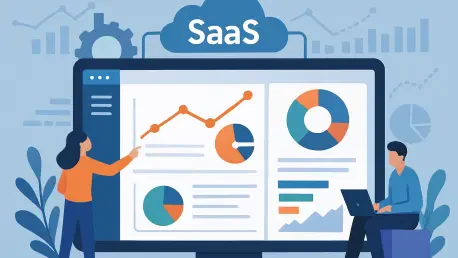In the rapidly evolving landscape of Software as a Service (SaaS), delivering exceptional value goes beyond mere functionality; it requires providing users with actionable insights right at their fingertips, and SaaS firms are increasingly embedding analytics directly into their platforms to achieve this. By turning vast streams of data into intuitive, real-time dashboards and reports accessible within the app itself, these companies are making a strategic move that is not merely a passing trend but a fundamental shift driven by the urgent need to empower users with data-driven decision-making tools while fueling business growth in an intensely competitive, data-centric market. Historically, both users and internal teams grappled with fragmented data trapped in siloed systems or delayed through cumbersome external reporting tools. By integrating analytics seamlessly into the product interface, SaaS providers are dismantling these barriers, ensuring that insights are immediate and relevant. This transformation enhances the user experience and positions companies to stay ahead by aligning with modern expectations for transparency and efficiency.
Driving Demand for Instant Data Access
The push for real-time insights stands as a primary motivator for SaaS firms to embed analytics within their platforms. Today’s users, whether individual customers or enterprise clients, expect instantaneous access to critical metrics like usage patterns, subscription details, or performance statistics without the delay of manual updates or the complexity of third-party software. Embedded analytics addresses this demand by placing up-to-the-minute data directly within the user interface, eliminating the need to toggle between applications. This immediacy not only saves time but also ensures that decisions are based on the most current information available, fostering trust in the platform. As data becomes a cornerstone of business strategy, SaaS companies recognize that failing to provide such accessibility could mean losing ground to competitors who do. The result is a user experience that feels fluid and responsive, aligning perfectly with the fast-paced nature of digital interactions in the current market.
Beyond the need for speed, embedded analytics empowers users through self-service capabilities that cater to a broad audience. Non-technical users, often lacking the skills to navigate complex data tools, can now interact with intuitive dashboards to monitor key performance indicators (KPIs) or analyze trends like customer churn rates. This democratization of data access meets a growing expectation for transparency, allowing users to take control of their metrics without relying on technical support or external consultants. Such autonomy enhances satisfaction by making the platform feel more personalized and useful, as users can derive insights tailored to their specific needs. For SaaS providers, this shift reduces dependency on customer service teams for basic data inquiries, freeing up resources for more strategic initiatives. It’s a clear signal that user empowerment is no longer optional but a critical component of maintaining relevance in a market where expectations continue to rise.
Enhancing User Retention and Streamlining Operations
One of the standout benefits of embedding analytics into SaaS platforms is the profound impact on user engagement and retention. By integrating data exploration tools directly into the app, companies create a seamless experience that keeps users within their ecosystem for longer periods. This “stickiness” is crucial in a competitive landscape where customer loyalty directly correlates with sustained revenue. When users can access dashboards and insights without stepping outside the platform, the friction of switching tools is eliminated, making the product an indispensable part of their workflow. This approach transforms the SaaS offering into a central hub for both functionality and analysis, reinforcing its value proposition. As a result, users are more likely to remain committed to the platform, reducing churn and fostering long-term relationships that are vital for business stability and growth in a crowded market.
Equally significant is the operational efficiency gained through embedded analytics for SaaS providers themselves. By enabling self-service data access, these tools drastically cut down on the volume of support tickets and custom report requests that typically bog down internal teams. Customer support staff and product developers can redirect their focus from repetitive data tasks to innovation and core product enhancements, optimizing resource allocation. This streamlining effect is particularly beneficial for scaling companies that need to balance growth with operational demands. Additionally, the reduction in manual reporting processes minimizes errors and delays, ensuring that internal decision-making is as agile as that of the users. For SaaS firms, this operational boost translates into a leaner, more focused organization capable of responding swiftly to market changes while maintaining a high standard of service delivery across all touchpoints.
Monetization Opportunities and Implementation Realities
Embedded analytics also unlocks substantial monetization potential, turning a functional feature into a powerful revenue driver for SaaS companies. By offering advanced analytics capabilities through premium pricing tiers, firms can cater to users seeking deeper insights or more sophisticated dashboards, creating an upsell opportunity that enhances profitability. Additionally, usage-based billing models allow companies to charge based on data consumption or report generation, aligning costs with value delivered. For enterprise clients, white-label solutions provide a chance to rebrand analytics as part of a customized offering, further expanding revenue streams. This shift transforms analytics from a mere cost center into a strategic asset, enabling SaaS providers to capitalize on the growing appetite for data-driven tools. As businesses increasingly rely on insights for competitive advantage, analytics becomes a key differentiator that can command a premium in the marketplace.
However, the journey to integrating analytics is not without significant challenges, particularly when considering in-house development. Building custom solutions often entails exorbitant costs, extended timelines that can stretch over months, and persistent maintenance burdens that divert focus from core product innovation. Security risks, such as inadequate compliance with data protection regulations or insufficient access controls, add another layer of complexity, potentially exposing companies to legal and reputational damage. Many SaaS firms are recognizing that partnering with specialized analytics platforms offers a more practical alternative. These third-party solutions provide scalable, secure, and feature-rich tools without the overhead of bespoke development. By leveraging such platforms, companies can deploy analytics faster, ensure robust data protection, and maintain focus on their primary offerings, ultimately achieving a balance between innovation and operational sustainability.
Charting the Path Forward with Strategic Integration
Reflecting on the adoption of embedded analytics, it’s evident that SaaS firms embraced this approach to meet escalating user demands and secure a competitive edge. The integration of real-time data tools within platforms addressed past frustrations with delayed insights and fragmented systems, delivering a user experience that was both seamless and empowering. This strategic pivot not only elevated customer satisfaction by providing immediate access to critical metrics but also optimized internal workflows, allowing teams to prioritize innovation over routine data tasks. Moreover, the monetization avenues that emerged turned analytics into a growth catalyst, reshaping how value was perceived and delivered.
Looking ahead, the next steps for SaaS providers involve refining the selection of analytics platforms to ensure seamless integration and scalability. Prioritizing features like full API access, white-label branding, and robust security measures will be essential to maintaining user trust and adoption. As market expectations evolve, continuous adaptation of analytics offerings to include AI-driven insights or personalized dashboards will likely define success. This ongoing commitment to enhancing data accessibility promises to solidify the role of embedded analytics as a cornerstone of SaaS strategy, driving both user value and business expansion in the years to come.









